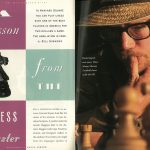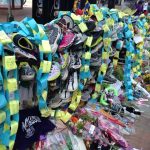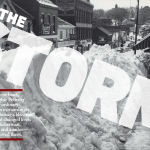The Making of The Vietnam War
How the film story of the most divisive event in America since the Civil War came to life in a small New Hampshire town.
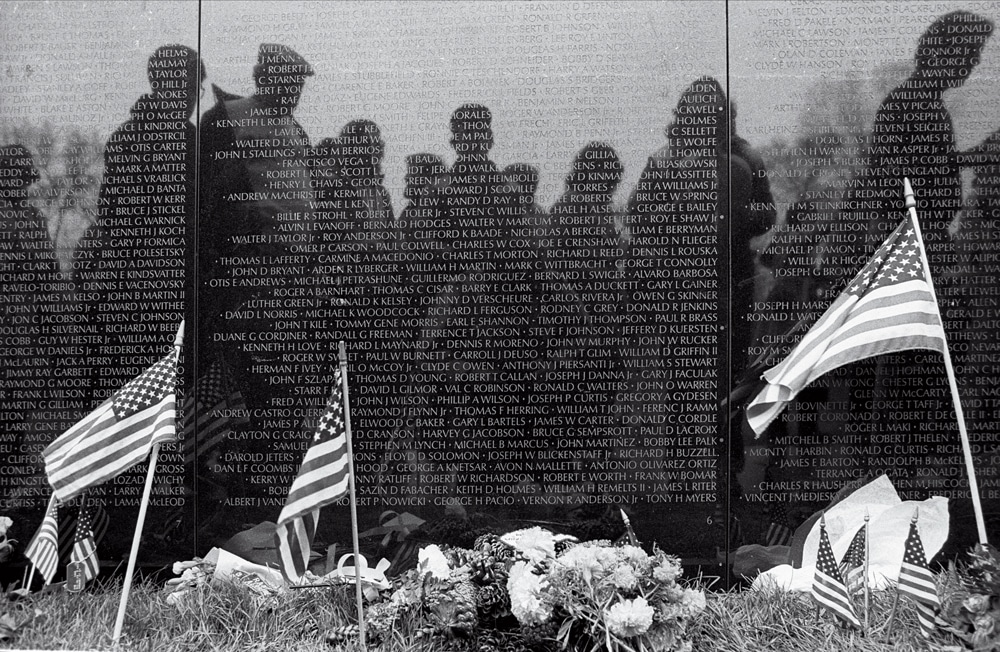
Coffee By Design | Portland, Maine
Photo Credit : Katherine Keenan“This Profound Place”
Even the children grow quiet beside the Wall. They seem to know to walk softly on the cobblestones—that though they are in a place they may not entirely understand, the black granite monument needs silence. Memorial Day: The air is cool, but promises to heat up. The formal ceremony at the Vietnam Veterans Memorial in Washington, D.C., where honored documentary filmmakers Ken Burns and Lynn Novick are speaking, will not begin until 1 p.m., but already, hours before, you can hear busloads of school groups chattering up and down the steps of the Lincoln Memorial and all along the grass-lined walkways of the National Mall. But when they reach the 58,318 names inscribed on the Wall, they quiet.
It’s been 35 years since the Wall was dedicated. Maya Lin was a 21-year-old Yale University architecture student when her design was chosen from among 1,421 entered in a national competition. She has said she learned the “power of names” while walking past Yale’s Memorial Rotunda, where the names of fallen alumni seemed to implore that she reach out to touch them.
Today some 5 million people visit the Wall every year, among them tens of thousands of veterans and parents, children, brothers, sisters, and friends of soldiers who died in Vietnam. Many leave a gift, a memory, from the lives they have been given to continue. The Wall offers them a place to lay it down.
Flowers. Dozens and dozens of bouquets are tightly clustered, lining the cobblestones. Single-stem roses are propped against the Wall, as if growing there. There are letters, too, many with photographs of soldiers who have the luminous faces of being 18, or 19, or 20. Someone leaves a pair of army boots. Someone else a faded green uniform. Eyes search the Wall, scanning the rows, then the hands follow, resting on a name. People hold scraps of paper against the Wall, rub them with pencils until a name emerges. Some kneel stiffly, then struggle to straighten. A woman looks on and murmurs, “They were all the same age then. They are the same age now.”

Photo Credit : Wolfgang Steche/Visum/Redux
By 1:00 the sun sears the stage where the invited speakers are sitting, facing the lawn. Someone gives Ken Burns a green floppy hat; beside him, Lynn Novick shades her face with a program. After the opening ceremonies, a woman named Julie Kink speaks about her brother, David, a helicopter pilot lost in Vietnam at age 19. She has spent 25 years tracking down the men who served with her brother. “Finding his friends brought me closer,” she says. “Not closure—closer. In his last letter home, my brother wrote, ‘You are never alone on a mission.’” She pauses. “Every name on that wall had a family, and that family is us….”
And then Burns and Novick, codirectors of The Vietnam War, which will enter America’s living rooms for 18 hours this September on PBS, step to the podium. “It is overwhelming to stand in this profound place,” Burns begins.
For 10 years, they and their team at Florentine Films have grappled with the complexity of their task. How to fit the story of a war that, as one soldier in the film says, “drove a stake into the heart of America” against the turbulent backdrop of the time: the internal politics, the battleground, the antiwar demonstrations; the terrible rifts between young and old, neighbor and neighbor; what happened to soldiers at war, and what happened when they came home. How to make a film that speaks to those who sought refuge in Canada as well as those who lost buddies and loved ones in Vietnam. How to reach both those old enough to remember everything and the newer generations. How to show viewers that there is another, all but unknown story: the other side. Vietnam, where hundreds of thousands of families were plunged into grief. Where they call it “the American War.”

Photo Credit : Associated Press
“You are the keepers of the complicated story we have tried to tell,” Novick says, looking out to the lawn where so many veterans are sitting. “In the past 10 years … we have searched for answers to so many questions. What really happened? Why did things go wrong? Who is to blame? Why do we avoid talking about the war? Why, decades after it ended, are we unable to put Vietnam behind us?” She pauses. “We did learn one important lesson of the Vietnam War. We will never again blame our soldiers for the policies of our leaders. Never again will we confuse our warriors with the war.” When she says this, the stillness is broken with an outpouring of applause and cheering.
Burns and Novick take turns telling about people they met along the film’s journey. There was the Marine, Burns says, who charged an entrenched machine gun position certain he’d be alone, but when he looked back, every member of his platoon was alongside him. Novick begins talking about a soldier’s mother who followed the war on television and worried when her son’s letters did not arrive. It’s a story Novick has seen play out over and over in their film, but her voice breaks in the retelling. “Then, on a beautiful day in 1966,” says Burns, picking up the tale, “she looked up and saw two men in uniform coming to the house….”
Burns and Novick say here what they have said many times before: The seeds of the deep discord in America today were sown in Vietnam. “Until we can find a way to talk, not shout across this divide,” Burns says, “the ghosts of the Vietnam War will continue to haunt us.”
Their movie carries a burden that they have placed on it with every interview, every screening—that, just maybe, it can provide common ground, the way this wall embraces everyone no matter their feelings about the war. It is as ambitious a project as we can expect to see now, maybe ever, on our televisions. And it began in a place as far from the fear and heat of a Vietnam firefight as any you can imagine: in the softness of the New England village that Ken Burns calls home.
“As Epic a Story as We Have Ever Tried to Tell”
When you drive to Walpole, New Hampshire, from the south, you pass a sugarhouse that serves pancakes with native syrup, then an apple orchard that overlooks the Connecticut River and Vermont to the west, and then a dairy farm that has been in the same family for more than 300 years. Moments later you find yourself in the heart of a village that Norman Rockwell would have painted, except Rockwell would have had to tear himself away from the chocolates at L.A. Burdick as well as the fine meals at its namesake restaurant. Just off the edge of the town green, trimmed with stately colonials and churches, is a house like many others, except the interior has been converted into filmmaking studios where film editors and sound mixers converge in the beating heart of Florentine Films.
On this day in mid-April I am meeting Ken Burns a few miles from the village center, at the property where he lives in an old farmhouse and works in offices and screening rooms nestled into two handsome barns. Though he is known as America’s greatest documentary filmmaker, Burns does not seek anonymity in Walpole. Townspeople see him dining at Burdick’s; he’ll often end the day there with staff and sometimes with the people whose stories they’ve filmed. Someone tells me which roads to follow to Burns’s place, noting that there are no signs to indicate that this is where many of the landmark films about America have been hatched: The Civil War, Baseball, Jazz, Lewis & Clark, Prohibition, and The Roosevelts, among many others.
When he arrived in Walpole in the summer of 1979, Burns was an impoverished 27-year-old filmmaker with his first film, Brooklyn Bridge, still two years away from its audience acclaim and subsequent Academy Award nomination. His New York landlord had just raised his monthly rent to $325, an impossible amount, and he’d found this farmhouse for only $225.
Burns knew rural New England from his student years at Hampshire College, on the outskirts of Amherst, Massachusetts. The school had drawn such notable faculty members as photographers Jerome Liebling and Elaine Mayes, who infused in Burns the desire to make documentary films. His final college film project took him to Old Sturbridge Village; there, for one of his last frames, he focused his camera on a painting of a farmhouse … then slowly panned to a factory. It was the earliest experiment with what later became known as the “Ken Burns effect,” in which archival photographs are filmed with depth and emotion, the camera teasing life from stillness. “Little did I know that I had just walked into my future,” Burns has said.
When he and a small cadre of other young filmmakers launched their company, they took the name Florentine Films from Florence, Massachusetts, home of their early supporter, Elaine Mayes. With The Civil War’s groundbreaking success in 1990, finances improved, and a few years later, when the Walpole landlord said he wanted to sell, Burns was eager to buy. He raised a family here, renovated one barn and built another, added a guesthouse, and bought the second house by the town green for his studios.
Today his private office is on the second floor of a white barn a few steps away from his home. When I enter, Chester, the family dog, barks a greeting from the top of the stairs. Burns has always possessed the aura of eternal boyishness; now, in his early sixties, there is gray in his black hair and mustache. He wears a sweatshirt and jeans, a scarf around his neck. Posters and photographs from nearly four decades of filmmaking line the walls. His office is small; a shelf of baseballs, a photo of Jackie Robinson, a jar of dust from the Dust Bowl all jostle for space.
He calls The Vietnam War “as epic a story as we have ever tried to tell.” The project began in late 2006, when he and Lynn Novick, one of his closest collaborators on many films, were putting the final touches on The War, about World War II. As he recalls it, they looked at each other and said, “The Civil War … The War. We’ve got to do Vietnam.” They both felt Vietnam was the most significant event in America since the end of World War II, “yet nobody talked about it, nobody understood it,” Burns says. “I lived through the entire Vietnam War, but in making this film, the first thing I understood was that I knew nothing.”
Two days after our visit Burns will be speaking at the University of Michigan, where, in a sense, this movie and all his others began. When he was 9, his family moved to Ann Arbor, where his father, Robert Kyle Burns Jr., began teaching in the anthropology department. Burns’s mother, Lyla, had been ill with cancer since he was 3, and impending tragedy hovered over their lives. In March 1965, his father helped organize the nation’s first antiwar teach-in. A few weeks later, Burns’s mother died; she was 43. Neither Burns nor his brother nor his father could cry at the service. But later he saw his father weep while watching a movie on television, and he recognized the power of film to awaken emotions. He knew then what he wanted to do with his life. Burns has long believed that “we experience history at its most impactful through the lives of ordinary people.” In his films, photographs of “ordinary people” shimmer as if alive. Years after he achieved fame, he would finally understand that his passion emerged from “a thinly disguised attempt to raise the dead. And there was really only one person I wanted to bring back.”

Photo Credit : Tim Llewellyn
With The Vietnam War, the task before Burns and Novick was to navigate the most wrenching years in America since the Civil War. To be willing to reopen wounds and reveal truths through “ordinary people” and their memories. To weave these truths together to connect nations once locked in a war neither ever truly understood.
There are hundreds of books about Vietnam, and the Florentine team dived in: from Tim O’Brien’s combat novels, to scholarly history and political analysis, to unpublished memoirs that were sitting forgotten in the Library of Congress. They combed through old news broadcasts and followed leads wherever they pointed—which in 2010 brought them to Tom Vallely, a decorated former Marine who was now an influential expert on modern-day Vietnam. He joined the team and helped open doors into that country, where the filmmakers found soldiers and civilians who had waited 50 years to be heard.
In a few years, they had files filled with people, more than 100, whose lives had been forever changed by the war: in America and Canada, and in Vietnam. The soul of the movie emerged when they heard stories that could tear a heart apart but also mend it in the telling. The artistry came next, “braiding them together,” then flowing in a soundtrack as memorable and as haunting as the words.
Burns talks about the “huge responsibility” that comes with turning the camera on someone who has rarely spoken about what happened half a century ago. There is the young doctor, Hal Kushner, whose helicopter is shot down and who is thrown into nearly six years of unimaginable hardship in enemy prison camps. Today he practices in Florida and vacations at his summer home in Maine, and rarely, if ever, relives those years. You watch him on an old newsreel as he first tastes freedom; later you watch him, now in his seventies, struggle to describe the indescribable. There is a Viet Cong soldier who says he will never forget peering through the jungle at Americans crying over the body of a friend and “seeing they were human like we were. They were like us.” And back home, a New York woman describes in a halting voice how she joined protestors shouting epithets at the returning soldiers, calling them “baby-killers.” “I just want to say I am sorry,” she says through tears. “We were kids, too.”
I tell Burns I’ve read that he’s called this his most “controversial” film.
“Only among those who don’t watch it,” he answers.
He continues, “The subject is controversial. The film is not. The film, I hope, is a work of art. I hope it’s the best film ever made. I suspect it’s not. But I really hope it is.
“Look, you understand that it’s thousands of hours down to 18? I mean, 18 is nothing. That’s short…. I always use the metaphor of maple syrup: 40 gallons of sap boiled down to one gallon of syrup. And that’s what we do. Subtraction. Yet sometimes we go the opposite way. We only had a single sentence about Kent State in the script. And I just happened to be giving a speech at Kent State. And they said they just opened this new little museum on what happened on May 4, 1970. It was no bigger than this office. I heard audiotapes and I came back here and said, ‘We’ve got to open it up.’ It’s an unbelievable scene. It hurt to watch it.
“I promise you,” he says, “there’s some really tough stuff in here. But not too tough. Particularly if you watch it with someone you love.” He looks at me. “Know what I mean? And have handkerchiefs. Because you will not get through this.”
In the screening-room barn, the Florentine team would show episodes from the film to groups that often included vets. “It was still raw, unfinished,” Burns recalls. “And these veterans would go out to smoke together or to hug each other or to cry. We had the head of programming for PBS sobbing and saying, ‘We’ll never put on anything more important than this.’”
Burns says again, “It’s really important not to watch alone.”
“The Winning Side”
There’s a gift that a few people possess that is almost impossible to describe, but you know you are in its presence when the camera closes in on someone who has known tragedy or terror and you, the viewer, feel as if you have been allowed to share a special secret. This is the gift of Lynn Novick.
“She is the best interviewer I have ever seen,” says Jack Todd. Today he is a well-known Montreal sportswriter, but long ago, when his Marine unit was deploying, he fled from the U.S. to Canada. His best friend had returned from Vietnam, pleading with him to get away. Leave, his friend said, leave. Years later, Todd wrote a memoir about what it was like to lose family and country, thinking he would never see either again. An estimated 100,000 American boys like him went to Canada, and his story in the movie became a way to show the reasons and consequences. “It was a powerful experience talking with Lynn,” he says.
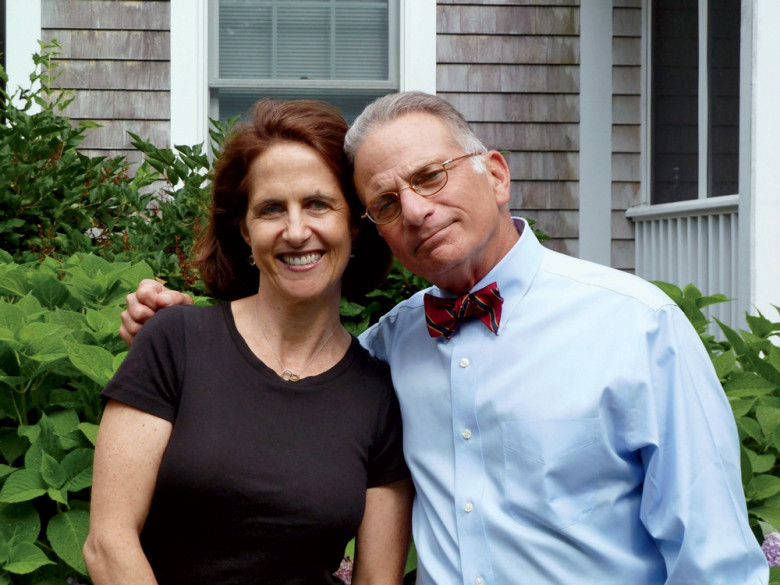
Photo Credit : courtesy of Dr. Hal Kushner
Now it’s the day after I met Burns in New Hampshire, and Novick is telling me about her years immersed in a war she was once too young to understand. “I knew something very important and serious and really bad was happening,” she says. “But I didn’t know why. I was a child.” During the making of the film, she made three intense trips to Vietnam, listening closely to voices that had finally found a listener. In America, too, she entered the lives of people who gave her permission to simply ask what it had been like. “There was a period of time,” Novick says, “there was a series of interviews that I did … I remember saying to Sarah [Botstein], our producer, that I feel my job is to make grown men cry. And I cry, too.”
We are sitting in a conference room at the Ash Center for Democratic Governance and Innovation at Harvard University, a few hours before a screening in a packed auditorium at the Fogg Museum. Beside her is Tom Vallely, who has forged a career at the Ash Center; today he is its senior adviser for mainland Southeast Asia and former director of its Vietnam program. He went from fighting the Viet Cong and North Vietnamese to eventually learning as much about them—their culture, their politics, how they think, their education system, how they have rebuilt a country—as anyone in America. “No one was more important to this movie than Tom Vallely,” Burns says. “He was a persistent guiding force. He opened our eyes to what we could do.”
Novick is describing an interview she did with a North Vietnamese army commander. “We have a lot of angst about the American bodies we have left behind,” Novick says, “and to this day there are still too many that have not been recovered (officially about 1,600). But there are 300,000 missing North Vietnamese. He told us how with so many of his soldiers who were killed, their families never got the body back and no one knows what happened to them. He said every day he gets a call from a family member of someone in his unit asking, ‘Have you found my son?’”
I ask her about coming in so close, so raw, day after day. “I did feel that it was OK to put people [in a place] where they would cry,” she says, “because they wanted to tell the story. And there was something so heroic and courageous to have these words come out. Those are excruciating and painful moments—but if you can tell them, there is something really brave about that.”
Vallely looks on, nodding. He and Novick have an easy familiarity, one that lets them be serious and then laugh moments later, that speaks to all their days together in a distant country, watching the film find its shape, and “nights without sleep, picking things apart,” as Vallely describes it. Novick chimes in, “Tommy would watch something or read something, and he would say, ‘You have it all wrong.’ Or, ‘You’ve left out this very important perspective.’”
What everyone involved with the movie knew was that time was running out. Great stories need storytellers, and on two continents the people with the stories of Vietnam were dying out. “If we didn’t make this film now, it couldn’t be made,” Vallely says.
“Ken and I knew from day one we were not going to tell only the American story,” Novick says. “We wanted to make sure we could understand what it was like in Vietnam. And the only way to do that was to go to Vietnam and to get to know people and to figure out what questions to ask them, and how to ask them. We didn’t know how we were going to do it. We just knew we would. And then we met Tommy.”
Tom Vallely had grown up outside Boston, in Newton, one of eight children of a judge and a mother raised in Vermont who felt the war was wrong and misguided. But in his head was “The Ballad of the Green Berets,” a song that all these years later he can’t listen to without wanting to fold up.
“It’s 1968. I’m in high school,” he recalls. “And I’m young. I’m believing in the American idea. I’m listening to John Kennedy’s words: ‘We shall pay any price, bear any burden, meet any hardship … to assure the survival and success of liberty.’” He joined the Marines and found enough hardships for a lifetime, as a member of I-Corps in Quay Nam, a region that saw constant fighting and that he today describes succinctly as “a tough place.”
Awarded the Silver Star for his actions during an August 1969 firefight, Vallely came home a hero from a war he no longer believed America could win. His certainty of the war’s futility led him to the Massachusetts congressional campaign of antiwar activist Father Robert Drinan. Vallely still looked the part of the battle-hardened Marine, and he became the heroic vet against the war that Drinan wanted on the trail. He also found kinship with another Massachusetts vet, John Kerry, whose opposition to the war would make him a national figure. Vallely and Kerry stood together on the National Mall in April 1971 with 1,000 other Vietnam vets, who threw medals and ribbons over a fence not to dishonor the soldiers in combat, they stressed, but to save them from a war that no longer should be fought.
Vallely had never been a brilliant student, but he was “street smart” and so made his way to Harvard, political consulting, and the state legislature. He became a leader in bringing the best and brightest young Vietnamese to Harvard on scholarship, and he was the guiding hand in establishing the Fulbright University in Vietnam. He knows modern-day Vietnam; he can maneuver, as he says, “in the neighborhood.” And as someone who could get things done in a country more than 8,000 miles away, he was exactly what Burns and Novick needed.
Yet at first he said no. “I’m not a historian,” he told them. “You want a scholar.” His son, Charlie, was incredulous. “Dad, do you know these people? You’d better go talk to them. They describe America to Americans, so you’d better call them back.”
Vallely did. “I showed them the winning side,” he says. “I introduced them to the people who won.”
I ask him what it was like to watch the unfolding episodes. I ask if he ever had to turn away. He shakes his head. “No,” he says quickly. “I’m very good at cleansing my emotions. I can get over something. I can handle it.”
Vallely adds, “My 19-year-old mindset is a very tough, not particularly emotional”—and he stops, swallows, cleansing, finishing—“killer.” Silence. Then, “I’m fine. I’m not that anymore.”
Novick continues the story: “Through Tommy, we had this extraordinary Vietnamese producer, Ho Dang Hoa, and we explained that we were filmmakers from America. What really struck me on a human level was to just sit and talk to someone like we are doing right now. And I’d say, ‘Tell me your story. What happened to you during the war?’ And I think they were open to telling it because they don’t get questioned about it that way. I would say something, and Hoa would translate. We said, ‘We want to know what it was like for people to live through it. We want to know what your family went through. What you went through. What you remember. What you think about it now.’ The same questions I would ask anyone here. I remember people saying things like, ‘You know, we never talk about what the war was really like—it’s too painful. But I want my children, I want my grandchildren, I want your country, to know what we went through.’ And ‘How can anyone understand the sacrifices that we made?’ And ‘How incredibly difficult this period was if we don’t talk about it.’ And ‘I’m old. And if I don’t tell you, then maybe that story will be lost.’”
Novick and Vallely are preparing to return to Vietnam to screen the film in translation two months before the U.S. premiere. “We’re showing the Vietnam side,” Vallely says. “We’re getting them ready for what’s going to happen. Oh, this film will shake up Vietnam a little bit. This will shake up this country a little bit. So get ready.”
Novick tells me about interviewing the mother that she and Burns would later mention in their Memorial Day speech at the Wall. “She was reliving the day for me when the soldiers came to the door. I’m not very religious, but something very profound happened in that conversation. And if that doesn’t change you, then you shouldn’t be doing this. So I don’t forget about her. She becomes a part of me, truly.”
A few weeks later, I phone the mother. Born in Massachusetts, she had raised her family a few hours’ drive away. I want to know what it was like to be on the other side of the Florentine Films camera. She says when she went to a screening in New York, she was overwhelmed, and spent the next day in her room. But she concedes the movie will be a legacy for her grandchildren and, one day, their children.
“This movie will make a difference,” she says. “People will be more accepting and respect what our children did. I don’t like to speak for other people, but this was so helpful to my son and daughter to share their feelings. For a long time, whenever someone said the word ‘Vietnam,’ they had to leave the room. This movie has changed that. Now they can talk about it. They are free.”




